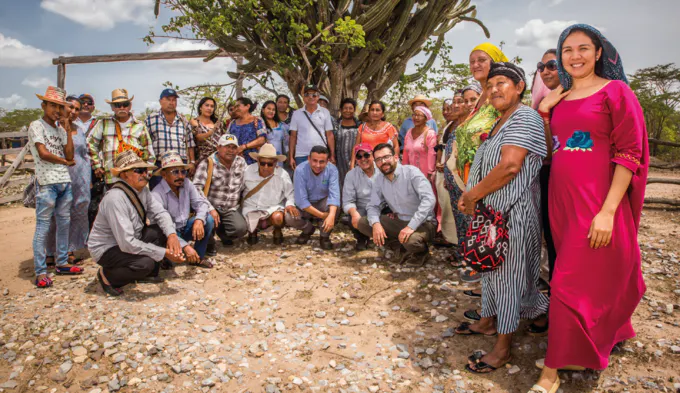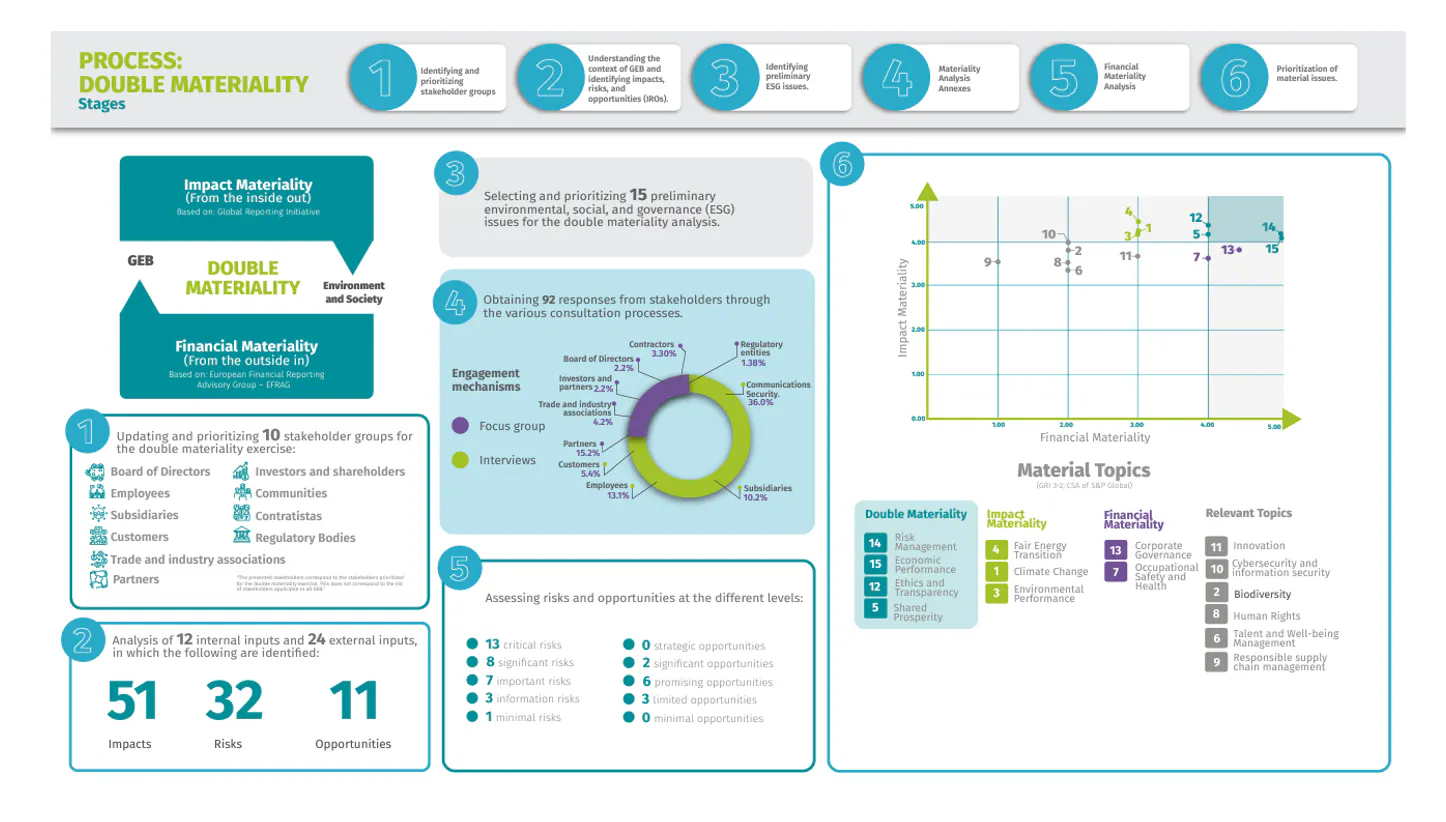

This exercise was developed using as reference some guidelines from the European Sustainability Reporting Guidelines 1 ESRG1 of the European Financial Reporting Advisory Group (EFRAG) as well as the Universal Standard 3: Material Issues 2021 of the Global Reporting Initiative GRI, as well as other documents, methodologies and guidelines related to the evaluation of impacts, risks and opportunities.
No. | Issue | Description | Topics included |
1 | Climate Change | Identifying, assessing and managing risks and opportunities associated to climate change (adaptation and mitigation), development of initiatives focused on energy transition. | Adaptation to climate change Mitigation and compensation of climate change |
2 | Biodiversity | Development of actions focused on the protection and conservation of biodiversity and ecosystem services in the areas of operation of GEB and its subsidiaries, including strategies based on the mitigation hierarchy (avoid, minimize, rehabilitate/restore and offset). | Ecosystem services Protection and conservation of biodiversity Mitigation and compensation of environmental impacts Ecosystem restoration |
3 | Environmental performance | Define and implement strategies to protect biodiversity and prevent, mitigate and restore and/or offset environmental impacts caused by the activities of GEB and its subsidiaries along its value chain. In addition, it includes the efficient use of natural resources, air quality, and the management of energy, water and waste. del aire, y la gestión de la energía, el agua y los residuos. | Use of natural resources Atmospheric emissions Energy efficiency Water management Waste management |
4 | Just energy transition | Prioritization of investments in projects for generation using renewable and non-conventional renewable energy sources, and the development of strategies and initiatives that contribute to accelerating energy transition and low carbon development. | Low carbon technologies Competitive energy. |
5 | Shared prosperity | Building conditions of well-being, progress and economic development in the communities of GEB and its subsidiaries’ areas of operations through the operations, infrastructure and services provided and the social investment programs implemented | Territorial development Access to products and services Relationship with communities |
6 | Talent management and well-being | Implementation of practices focused on the development, attraction, retention, well-being and capacity-building of GEB employees and its subsidiaries in a way that ensures compliance with strategic objectives. | Working conditions Employment practices Adequate salary Strengthening skills Talent attraction and retention Corporate culture |
7 | Health and safety at work |
Managing employee and contractor safety and health, including prevention of injuries and illnesses caused by work conditions, as well as promoting the well-being of the employees. | Health and safety at work for employees and contractors |
8 | Human rights | Fulfillment of commitments and implementation of mechanisms to care for, prevent, mitigate and protect the Human Rights of GEB's stakeholders and value chain. Includes the management of diversity and inclusion. | Diversity, equity and inclusion Due diligence Training and awareness Human rights risk management |
9 | Responsible supply chain management | Responsible supply chain management, including ethical, environmental and social standards, promoting the hiring of local employees and suppliers, training and development of suppliers and contractors. | Local supply |
10 | Ethics and transparency | Promote integrity, transparency and ethical behavior in the GEB and its subsidiaries to strengthen the trust and long-term relations with all stakeholders. | Responsible business conduct Conflict of interests Corruption and bribery Taxation Information management |
11 | Corporate governance | Implementing mechanisms for decision-making that generate profitability, competitiveness, transparency, trust and sustainability for all the Group’s companies, through a robust Corporate governance. | Management of subsidiaries Ownership structure Transition of boards of directors |
12 | Risk management | Comprehensive risk management, including the identification, assessment, definition and implementation of controls, monitoring and review, in order to prevent and mitigate the materialization of them. | Critical incident risk management Emergency preparedness Process security Third party actions |
13 | Cybersecurity and information security | Proper management and handling of information security, prevention of cyber-attacks, privacy protection and confidentiality of stakeholder data. | Information security Cybersecurity risks |
14 | Innovation | Development and implementation of technological and innovative products and services that allow the incorporation of new sources of sustainable value according to the superior purpose and dynamics of the markets in which GEB and its subsidiaries operate. | Digital transformation Innovation ecosystem Culture and knowledge management New businesses New technologies |
15 | Economic performance | Economic performance, financial stability and sustainable growth. | Business profitability Generation of value for investors and shareholders |
Material issues for creating business value
Of the identified material issues, Climate Change; Shared Prosperity; and Occupational Safety and Health can have a high impact on GEB's business and the generation of long-term value. These three topics are integral to GEB’s corporate strategy and act as catalysts in achieving its higher purpose and vision for 2030.
Climate Change | Shared Prosperity | Occupational Safety and Health |
|
|
|
Risk | Risk | Cost |
Climate Change | Shared Prosperity | Occupational Safety and Health |
|
|
|
Climate Change | Shared Prosperity | Occupational Safety and Health |
Achieve emissions reductions at least equal to those established in the Nationally Determined Contributions (NDCs) of the countries in which GEB and its subsidiaries operate. • Colombia: 51% by 2030. • Peru: 30% by 2030. • Brazil: 43% by 2030. • Guatemala: 11.2% by 2030.
Achieve carbon neutrality in all GEB operations by 2050. | The following targets have been set to improve the conditions for progress and social development in the communities within the operational areas of GEB and its subsidiaries:
| Materialize the "Zero Accidents Vision," beginning with fatal accidents and achieving significant reductions in lost-time work accidents:
|
The Board of Directors of GEB approved another goal in 2023, aimed at achieving GHG emission reduction targets within GEB and its controlled subsidiaries.
The variable compensation of all employees, including the CEO and GEB managers, was contingent upon the accomplishment of 9 company objectives. These included the reduction of emissions, which had a weight of 10% of the total. | In 2023, one of the objectives approved by the Board of Directors of GEB was to improve its performance in social affairs management, given its importance for creating conditions of shared prosperity and value generation for its stakeholders.
To measure this aspect, one of the 2023 goals is to improve GEB's position in the social dimension ranking of S&P Global's Corporate Sustainability Assessment. The above is considering that this dimension includes fundamental issues for the shared prosperity strategy, such as Human rights and Stakeholder Engagement. The weighting of this goal with respect to the total of indicators was 10%, and its fulfillment rate was 120%.
Fulfillment of the 9 indicators that make up the GEB corporate objectives determines the variable compensation for all employees, the CEO, and the executives. | In 2023, a corporate objective approved by GEB's Board of Directors was to improve its Occupational Safety and Health performance, measured via the Lost Time Injury Frequency Indicator (LTIF).
This target was included with the aim of maintaining the OSH performance achieved in recent years. The target for 2023 consisted in reducing lost time incidents, and a Proactive Performance indicator.
The variable compensation of all employees, including the CEO and GEB managers, was contingent upon the accomplishment of 9 company objectives. Among these was the LTIFR indicator, which contributed 10% to the total. |
During 2023, Grupo Energía Bogotá updated its material topics using the double materiality approach, which identifies and prioritizes the Company’s impacts, risks and opportunities from a perspective of impact materiality (the impact of GEB and its subsidiaries on the environment) and financial materiality (impact of the environment on GEB and its subsidiaries).
The 10 identified internal and external stakeholder groups participated in the assessment process of potentially material topics from the impact materiality approach. Additionally, a preliminary assessment was carried out of ESG topics related to impacts, through stakeholder consultations (surveys, interviews, and field visits), obtaining 92 responses. Each group evaluated GEB's potential material topics based on:
- Significant (both positive and negative) social, environmental, economic, and governance impacts of GEB and its subsidiaries.
- Critical social, environmental, economic, and governance risks/challenges facing GEB and its subsidiaries currently and in the long term.
- The main opportunities (social, environmental, economic and governance) identified in the context that would help increase the positive impacts of GEB and its subsidiaries.
As a result, and aligned with previous materiality exercises, the most relevant material topics for external stakeholders continue to be "Shared Prosperity" and "Just Energy Transition"
Stakeholders & materiality



